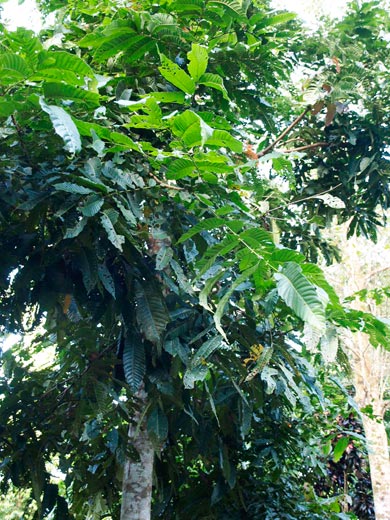| PROTO-POLYNESIAN ETYMOLOGIES |
| *Tawa |
Pometia pinnata, "Island lychee " (Sapindaceae). |
|
From
PROTO EASTERN MALAYO-POLYNESIAN *tawan, Pometia pinnata , "Island lychee" (Sapindaceae).
through PROTO OCEANIC *tawan, Pometia pinnata
and PROTO Central Pacific *tawa, Pometia pinnata. |
Proto Polynesian: *Tawa
REFLEXES IN SOME POLYNESIAN LANGUAGES:
Tongan, Niuean, Samoan, Rarotongan : Tava (Pometia pinnata, "Island lychee", Sapindaceae)
Tuamotuan: Tava (Pandanus sp., Pandanaceae)
Maori: Tawa (Beilschmeidia tawa, Lauraceae); also possibly Tawapou (Planchonella costata, Sapotaceae)
|
|
|
|
COGNATE REFLEXES IN SOME OTHER AUSTRONESIAN LANGUAGES
Sursurunga (New Ireland, Papua New Guinea): taun (Pometia pinnata, "Island lychee", Sapindaceae)
Sursurunga (Banks Island, Vanuatu): tawan (Pometia pinnata)
Wayan Fijian: tawa (Pometia pinnata)
Bauan Fijian: dawa (Pometia pinnata). |
|
|
|
This important tree is thought to have originated in New Guinea, and its Proto Eastern Malayo-Polynesian name can also be traced back to the period when Austronesian explorers headed east from the Philippines to near Oceania. It appears to have been domesticated in New Guinea for its fruit long before the arrival of the Austronesians. The ripe fruit is sweet and tastes similar to the lychee, hence its English common name. In the forest it grows from 20 to 45 metres tall, as a canopy hardwood, but it is mostly 12 to 20 metres high in cultivation. It has large butress roots, and this plus the elongated leaves and straight trunk may account for its name having been used for an otherwise quite different tree in Aotearoa (see link above). The timber can be used for building, but it seems that the fruit is the greatest attraction, especially in New Guinea, Fiji and Tonga. Pometia pinnata was introduced as a "canoe plant" in some parts of the Pacific but seems to be native to Samoa.
|

|

[Left] Tava (Pometia pinnata),
Botanical Garden of Samoa, Tiapapata
[Above] Tava (Pometia pinnata),
Detail showing leaves and part of trunk. |
|
| Further information : There is detailed linguistic information and other commentary about Pometia pinnata in The Lexicon of Proto Polynesian, Volume 3 (See Bibliography), and comprehensive information about the tree itself in the Traditional Tree Organization's agroforestry bulletin on this species. The Cook Islands Biodiversity database also has a page on Pometia pinnata. |
| Photographs: (Te Māra Reo; R.B.) |
|
|

